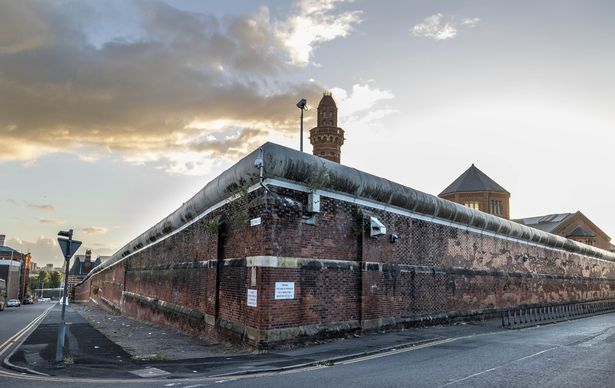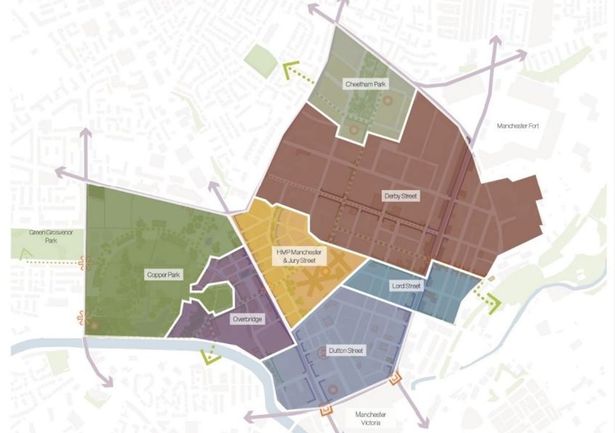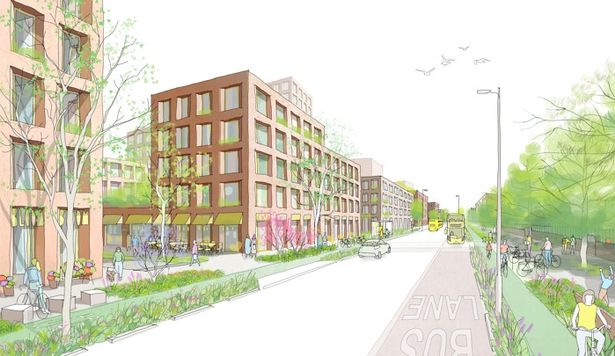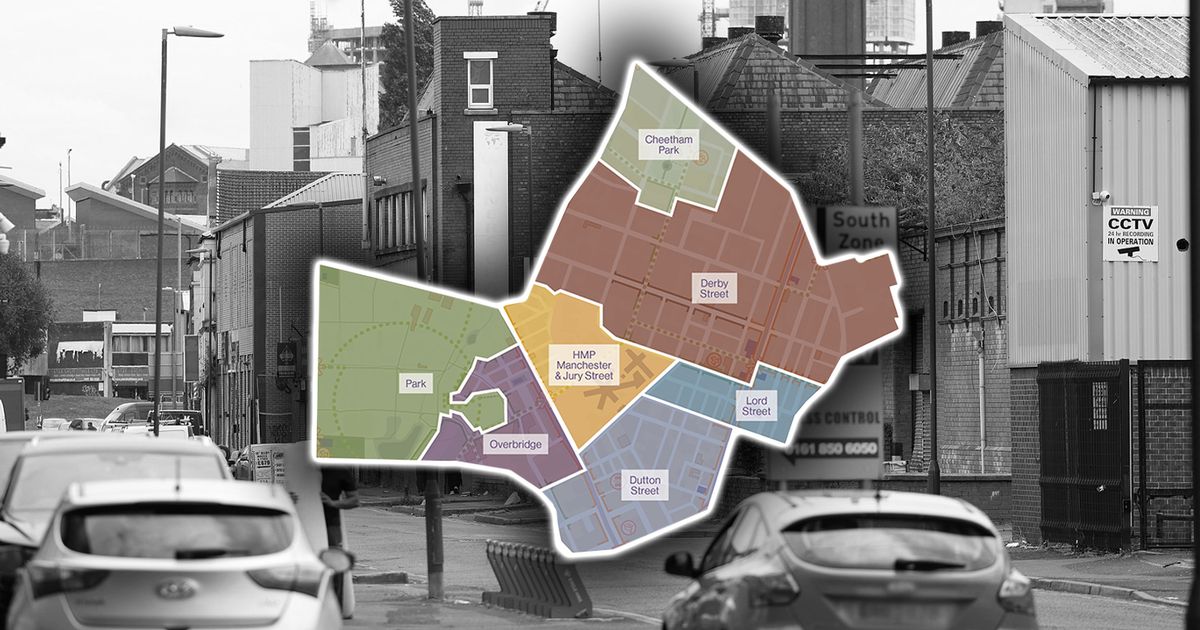The site of HMP Manchester ‘offers a truly transformational opportunity to create a new city quarter’ Strangeways(Image: Manchester Evening News)
Strangeways(Image: Manchester Evening News)
A ‘milestone’ vision for real change to the sprawling ‘city fringe’ area around Strangeways reveals plans for seven new and distinct neighbourhoods.
Council bosses in Manchester have also repeated a plea to the Government to consider again the relocation of Strangeways prison, saying the almost 20-acre site of HMP Manchester ‘offers a truly transformational opportunity to create a new city quarter’.
The town hall argues the Victorian jail’s listed buildings could be re-used ‘to provide potential innovation and economic uses’, calling Strangeways as it is a ‘barrier to the economic and physical growth of the city centre’.
The plans to create what was called a ‘significant regeneration initiative’ to breathe new life into an area spanning more than 320 acres on Salford’s border with Manchester were first unveiled in 2023.
Join the Manchester Evening News WhatsApp group HERE
The two city councils joined forces to draw up a masterplan – a Strategic Regeneration Framework (SRF) – for the area. Now the exciting blueprint for the future – which maps out the seven districts in detail and reveals their names – is set to be endorsed and approved by councillors next week, paving the way for work to begin in earnest.
“It will be an area of significant residential and commercial development in the years ahead, and key to the growth trajectories of both cities and Greater Manchester as a whole,” councillors will be told at key meetings next week.
“Existing businesses will be enabled to expand, and economic activity will be intensified, whilst new green and open spaces will be created for the benefit of both existing residents and those set to move into the area as thousands of new market and affordable homes are built in the years ahead.”
 Plans are set to be approved next week(Image: Manchester Evening News)
Plans are set to be approved next week(Image: Manchester Evening News)
The zone includes Manchester’s once infamous ‘Counterfeit Street’ – the warren of illicit traders around Bury New Road now completely closed down by police – and the Cambridge industrial area in Salford.
The exact area extends north from the Inner Ring Road, adjacent to Manchester Arena and north-east of the River Irwell. The Cambridge area is defined as crossing Sherbourne Street up from Mary Street, and up Edward Street to Broughton Lane. It goes down Great Clowes Street and back down to the River Irwell at Broughton Bridge, then across back to the bottom of Cottenham Lane.
Bury New Road, Cheetham Hill Road and Cheetham Park are covered. The vision, said Manchester council, was for Strangeways and Cambridge to ‘become a vibrant and successful extension to the city centre’.
Council leaders, meanwhile, have hailed the launch of ‘an incredibly exciting decade and more for Strangeways’.
The aim is to support businesses, new and existing, build new houses and commercial space, and create a new urban public park spanning almost 150 acres – Copper Park. The framework estimates the area could accommodate some 7,000 new homes, split into the seven neighbourhoods, together with envisaged new health facilities.
 An artists impression of the planned park
An artists impression of the planned park
Strangeways Prison, however, looms large over the plans. Long the subject of council ire after numerous pleas to Government to consider HMP Manchester’s relocation, documents reveal the framework will now be ‘used to engage with the Ministry of Justice on the long-term future of the prison’.
A draft of the framework was even shared with ministers and civil servants with regard to the prison’s future, it’s been revealed.
Manchester City Council said it would use the framework to push forward the case for Strangeways’ relocation.
Papers set to be considered by councillors next week reveal: “The council will use the SRF and the underpinning economic analysis to continue to make the case to the Ministry of Justice for the relocation of HMP Manchester. Whilst it is recognised that the future of HMP Manchester is tied into wider discussions around future prison capacity within England and Wales, the council will continue to engage with the MoJ to make the case for the repurposing of the site as part of the department’s long-term capital plans for prison capacity.
“The council has maintained for some time that the eight hectare prison site is a barrier to the economic and physical growth of the city centre.”
 HMP Manchester(Image: MEN Media)
HMP Manchester(Image: MEN Media)
The seven new neighbourhoods have been named and set out in a map as part of the framework:
Dutton Street: Bordering Manchester Victoria, it’s set for residential houses and commercial buildings. Manchester City Council said ‘significant development and investment’ was already underway there.Lord Street: An area connecting to Dutton Street, with a ‘traditional employment core’ in and around a planned Derby Street neighbourhood. The proposed neighbourhood is said by the council to play ‘a key role’ in connecting into the Red Bank neighbourhood to the east.Derby Street: Billed as the ‘long-standing employment core of Strangeways and Cheetham’, the area has been singled out for employment and commercial use. A ‘greater variety’ of workspaces, however, is planned, using existing and new buildings.Cheetham Park: The proposals envisage a new residential neighbourhood framed around the historic Cheetham Park. The seven proposed new neighbourhoods(Image: Manchester City Council)Overbridge: Acting as the gateway to Copper Park from the city centre, the council said it would be ‘an area of significant potential for residential development with ground and lower floor employment uses, which could include the use and repurposing of existing heritage buildings’. New leisure uses are also planned to ‘spill out’ into the park.Copper Park: Billed by the council as ‘a large new open space incorporating areas of both Manchester and Salford’. The council said it could offer ‘sports, play and wellness, and opportunities for large scale cultural events along with nature-based experiences, making it a key local amenity’.HMP Manchester and Jury Street: The council said the long-term future of the area would be ‘dictated by government decisions around the prison’. Under the plans, the Jury Street area would continue as a zone for employment and commercial uses. The new city quarter vision would also be considered, with any change to the prison.
The seven proposed new neighbourhoods(Image: Manchester City Council)Overbridge: Acting as the gateway to Copper Park from the city centre, the council said it would be ‘an area of significant potential for residential development with ground and lower floor employment uses, which could include the use and repurposing of existing heritage buildings’. New leisure uses are also planned to ‘spill out’ into the park.Copper Park: Billed by the council as ‘a large new open space incorporating areas of both Manchester and Salford’. The council said it could offer ‘sports, play and wellness, and opportunities for large scale cultural events along with nature-based experiences, making it a key local amenity’.HMP Manchester and Jury Street: The council said the long-term future of the area would be ‘dictated by government decisions around the prison’. Under the plans, the Jury Street area would continue as a zone for employment and commercial uses. The new city quarter vision would also be considered, with any change to the prison.
The new vision is set to tie in with existing developments around Great Ducie Street and the former site of Boddingtons brewery.
The council, however, has stressed the plans are a ‘potential’ realisation which would be subject to a host of ‘variables’ including the economy and public and private investment. The framework could also change as the years pass. The council said it would ‘continue to monitor’ the demand and supply of school places in the area.
 A new image of how Strangeways might look
A new image of how Strangeways might look
But councillor Bev Craig, leader of Manchester Council, called the news a ‘milestone’ and said ‘vision would now move to delivery’ as part of the long-term regeneration plans for the area.
She also hailed the beginning of ‘an incredibly exciting decade and more for Strangeways’. “We know this is an area that has faced challenges, and we have worked closely with partners – including GMP through Operation Vulcan – to create lasting change and opportunity for these neighbourhoods,” Coun Craig said.
“This is about supporting businesses, creating jobs through growth, and building the homes our residents need in neighbourhoods that they are proud of.”
Salford mayor Paul Dennett said the development of the framework ‘marks a significant step forward in our shared journey to transform the area into a thriving, connected neighbourhood’. Detailed flood modelling, he added, had been utilised.
“With strong community roots and a rich cultural heritage, this area is brimming with potential and together we can deliver transformational change creating new homes, jobs and green spaces that reflect the aspirations of our residents and support a greener, fairer future,” coun Dennett said.

